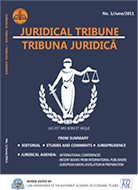Legal liability through the prism of the new conceptual mutations
Legal liability through the prism of the new conceptual mutations
Author(s): Mihai BădescuSubject(s): Law, Constitution, Jurisprudence
Published by: Societatea de Stiinte Juridice si Administrative
Keywords: law; concept; conceptual mutations; legal liability; responsibility; legal parthenogenesis;
Summary/Abstract: The concept of legal liability is traditionally approached, first in the General Theory of Law, then in each branch legal discipline. From this perspective the role of this fundamental concept of law is emphasized, the legal liability is defined and classified in its main forms (disciplinary, civil, administrative, criminal), the conditions for engaging inany form of legal liability are highlighted. The present study does not aim to analyze whatis known, which is not lacking in any academic course of law theory, which has been the subject of numerous writings in the field, including within national doctoral research and not only. Through this study, we aim to highlight the fact that at present there are serious reasons to believe that, compared to the traditional coordinates of the legal liability analysis, we are in the presence of changes, conceptual mutations that play a role within it as a reflection of either the phenomenon well known as legal inflation, or the need to adopt the norms of the right to new social coordinates, to the mutations that take place - thanks tothe celerity with which social relations unfold - in social life. In other words, in addition to the branches of law that conventionally analyze the concept of legal liability, it is necessary to emphasize also the appearance of other branches with their specificity, including from the point of view of the legal liability that is committed. We come up with these considerations to analyze a new concept, legal parthenogenesis, a consequence and effectof these social mutations on forms of legal liability. Therefore, the present study has as a major objective the disclosure of other forms of legal liability alongside those already known. The research methods used are the epistemological, historical, comparative, and teleological methods. The results of the study can be used in the new doctrinal approaches in the field, within the three levels of higher education: BA, MA, and PhD.
Journal: Tribuna Juridică
- Issue Year: 7/2017
- Issue No: 14
- Page Range: 115-123
- Page Count: 9
- Language: English

